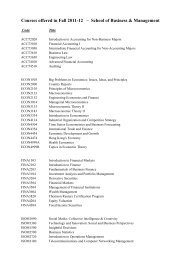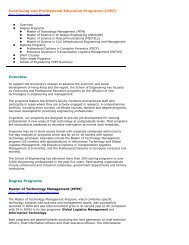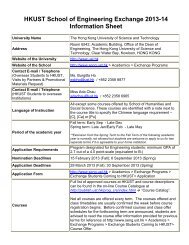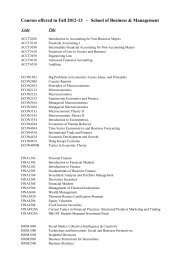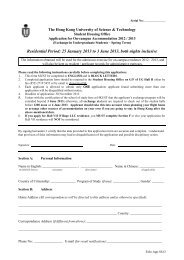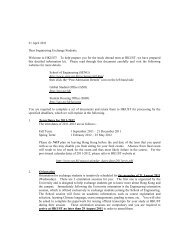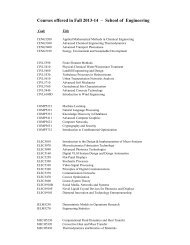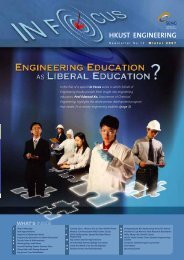pdf version - seng, hkust
pdf version - seng, hkust
pdf version - seng, hkust
Create successful ePaper yourself
Turn your PDF publications into a flip-book with our unique Google optimized e-Paper software.
Major Research Areas<br />
Biomedical Electronics<br />
Research includes: development of silicon models of multidimensional selectivity in<br />
the visual cortex, modulatory feedback in multi-chip neuromorphic networks, microelectro-array<br />
technology for cell level biological signal processing, micro-electro-DNA<br />
detection system by microfabrication techniques, non-invasive imaging technology<br />
for early detection of cancers, sensors for non-invasive quantification of important<br />
biological analytes, visual information processing and its applications in medicine,<br />
system modeling of physiological functions, optical coherence tomography for in vivo<br />
imaging human tissue, ultrasound image analysis, genome-wide SNP data analysis,<br />
and computational proteomics.<br />
Ecotronics<br />
Research in solid-state electronics, including both devices and circuits, is a core<br />
strength of the Department. Ecotronics, a new focus area of the Department,<br />
encompasses the research and application of solid-state electronics to address<br />
environmental and energy-related engineering problems. Projects being pursued<br />
are solid-state lighting, solar cells, smart grids, energy-efficient electronics and<br />
electronics for the smart use of energy and power saving (green) LCDs including<br />
E-paper LCDs (FLC, ORW).<br />
Embedded Systems<br />
Research focuses on: embedded<br />
system architecture including<br />
hardware/software balance and<br />
tradeoff, system evaluation and<br />
integration, network-on-chip and<br />
multi-core system-on-chip, mobile<br />
embedded systems, cyber physical<br />
systems, computer vision and<br />
sensing systems with application<br />
to instrumentation and control,<br />
data-domain con<strong>version</strong> between<br />
analog and binary or multiple-valued<br />
digital signals, man-machine systems,<br />
low-power low-energy embedded system<br />
design, and VLSI design targeting mobile<br />
computing, multimedia, and high-speed<br />
network applications.<br />
IC Design<br />
Research focuses on: advanced digital and<br />
analog integrated circuit designs for use in<br />
a variety of applications including wireless<br />
communications, power electronics, smart<br />
sensing, embedded systems and control.<br />
Particular examples are advanced techniques<br />
for digital signal processing, image and<br />
speech processing, telecommunications,<br />
biomedical electronics, image sensors,<br />
temperature sensors, electronic nose,<br />
integrated power electronics, analog<br />
implementation of biologically inspired vision<br />
processors, and high performance analog<br />
integrated circuits for wireless communications such<br />
as RFID, Wifi, LTE and biomedical applications.<br />
Microelectronics<br />
• In this area we fabricate real devices for applications<br />
and advances at the frontiers of nanotechnology<br />
and electronics research. Our work leverages the<br />
university’s Nanoelectronics Fabrication Facility<br />
(NFF), which is a complete facility capable of<br />
handling four-inch wafers.<br />
• Research includes: advanced semiconductor<br />
materials preparation and characterization,<br />
microwave and high-frequency semiconductor<br />
devices, power semiconductor devices and<br />
technology, thin film and display devices, advanced<br />
integrated circuits fabrication technology, integrated sensor and transducer technology, and<br />
micro-electro-mechanical systems (MEMS).<br />
Dean’s Message Generating Global Impact Inspiring Future Leaders Tackling the Grand Challenges Cultivating Wider Vision Empowering Excellence Driving the Future<br />
49




